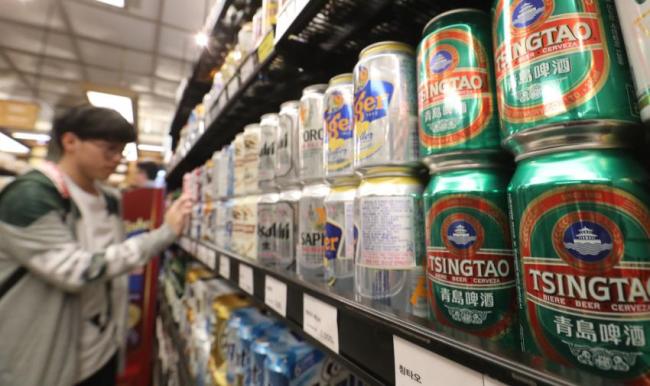Cass has long been a household name in Korea — even to those who do not imbibe.
Korea’s No. 1 beer maker Oriental Brewery has been around for over 80 years, but it has only recently been making moves into overseas markets like China.
Even for a well-established brand with sales of 1.5 trillion won ($1.4 billion) in 2016, the reason is clear and simple — local beers aren’t selling so well in Korea.
Korea’s beer market had long been dominated by two local power brands: Cass by OB and Hite by Hite Jinro. Lagers accounted for more than 90 percent of the market.
However, recent trends here have moved beer lovers away from the common brands toward imported beers, which have not always had a strong presence here.
In fact, the only type of alcohol thriving in the domestic liquor industry is imported beer, according to industry insiders.
Between January and July in 2017, beer topped the list of alcohol imports for the first time, surpassing wine and the longtime No. 1 whiskey, according to the Korea International Trade Association.
During this period, beer imports hit $143.9 million, a 50.5 percent increase on-year. The figure is notable considering it was only in 2014 that domestic beer imports first reached $100 million.
By volume, beer imports hit 220 million liters in 2017, almost a threefold increase compared to 2012’s 74.7 million. Industry insiders say the figure will hit 300 million for the first time this year.
Japan and China were the top two exporters of beer to Korea, but countries like Belgium and Ireland are rapidly increasing as ale, rather than lager, is becoming more popular, especially among younger consumers.
Major convenience store chains GS25, CU and 7-Eleven — which promotes aggressively by offering four cans for 10,000 won — have also seen sales of imported beer surpass 50 percent among total revenue of beer. Superstore chain E-mart said that imported beers accounted for 51.2 percent of sales of beer at their stores countrywide.
Retailers view a growing culture of drinking solo, or “honsul,” as leading those in their 20s and 30s to simply grab a low-alcohol foreign beer, without having to go out to drink.
“When I walk into the convenience store or imported beer section at local marts, I find it very interesting and enjoyable, just by looking at a variety of colorful and cheap foreign beers,” said Jang Ye-ji, 31-year-old office worker living in Seoul.
Various and consistent promotional events offered at the convenience stores and retail chains offering bundles of foreign beers at cheaper prices have definitely played a major part.
This has been possible due to different tax rates imposed on local and foreign beers.
According to the Liquor Taxation Act, taxes on domestic beers are levied in accordance to their factory prices, including costs for marketing. Taxes on imported beers are based on the sum of their production costs and tariffs, which do not include marketing expenses.
Many Korean breweries have regarded the regulation as a discriminatory measure against Korean beer, saying “importers are practically receiving special treatment.”
“Foreign beer companies can control the retail price by reducing distribution margin, and they can even report (to authorities) a much lower import price to decrease the amount of tax. But honestly, there is no way to check the original import price,” said an official a major Korean brewery.
From this year, the government has also removed restrictions on beer importers and craft beer brewers.
Beers imported from the United States and European Union have become or will become exempt from tariffs, starting from this month and July, respectively, under the terms of free trade agreements that Korea signed with each.
Against this backdrop, industry experts say more local beer makers will have to make the foray into overseas market.
Hite Jinro, one of the top beer makers here, officially announced it would use Vietnam as a gateway to up its presence in Southeast Asia.
The company aims to achieve 530 billion won in overseas sales of Hite beer and Jinro soju by 2024.
“We will develop tailored marketing solutions and strengthen our sales network to win the hearts and minds of consumers in Vietnam, where the Korean pop culture is immensely popular and consumers have a stomach for strong liquor,” said the company’s CEO Kim In-kyu in Hanoi, Vietnam, last year.
The company has already seen sales increase sevenfold in Hong Kong, following aggressive and focused marketing over the past five years.
“Japanese breweries have faced decreasing alcohol consumption over the past decades. What they have sought, as part of their breakthrough, was to acquire stocks or buy other overseas alcohol companies. This, may be the future and reality of Korean beer companies,” said an official from the local alcohol industry.
By Kim Da-sol ([email protected])


